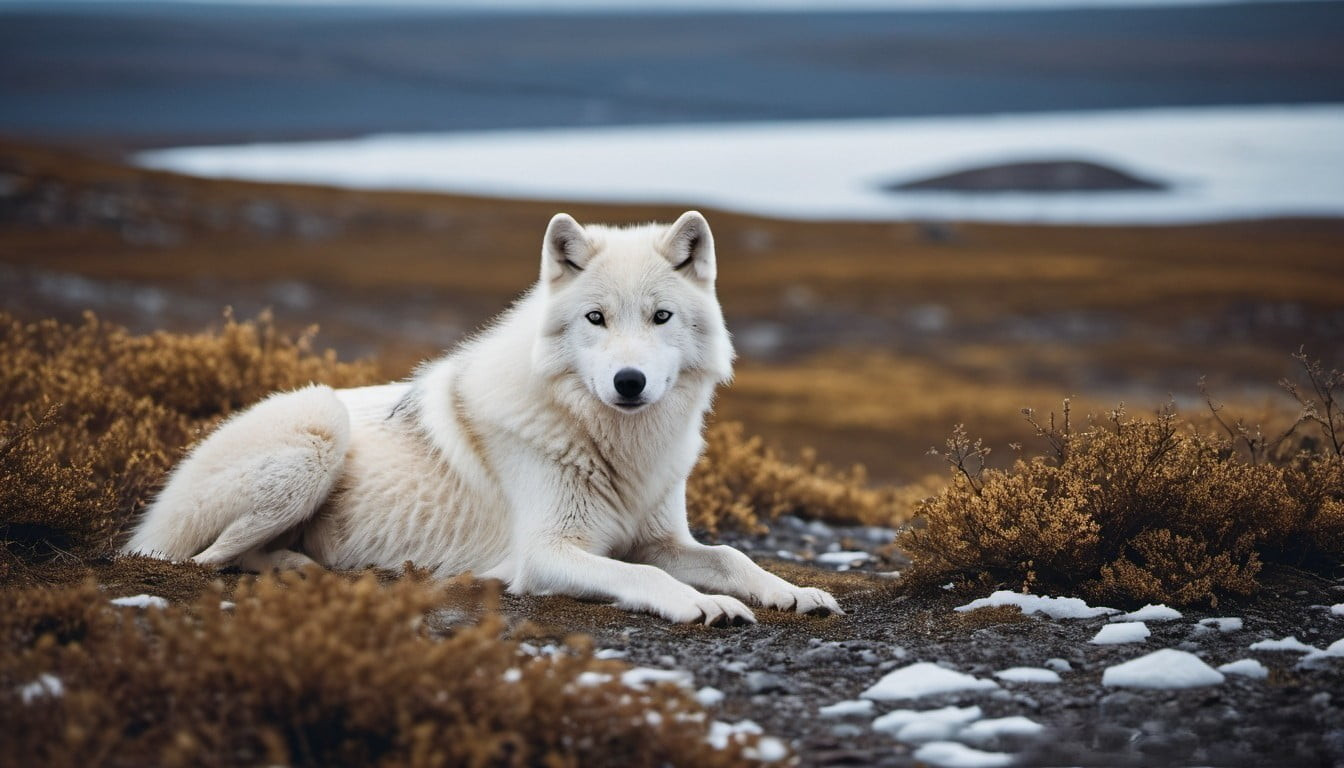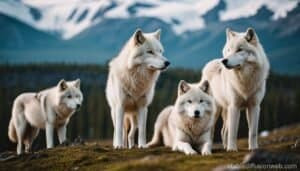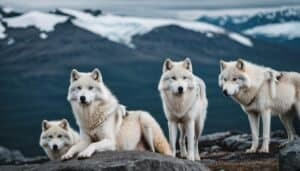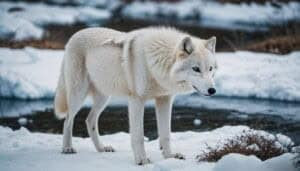Introduction
The Arctic wolf, a resilient predator, thrives in one of the harshest environments on Earth
This article explores how its habitat changes between seasons, focusing on the differences in climate, prey availability, and behavior during winter and summer. We’ll also discuss the challenges Arctic wolves face during seasonal transitions and their role in the ecosystem throughout the year
Arctic Wolf’s Habitat in Winter
The Arctic wolf’s habitat undergoes significant changes in winter. Understanding these changes is crucial for comprehending how these resilient creatures survive and thrive in such a harsh environment
Climatic Conditions in Winter
During the winter months, the Arctic is characterized by extreme cold, with temperatures often plummeting below -30°C (-22°F). The landscape is blanketed in deep snow, and ice covers most bodies of water
The days are short, with the sun barely rising above the horizon, leading to long, dark nights. Winds can be fierce, contributing to the bone-chilling conditions. This harsh climate presents a challenging environment for the Arctic wolf, requiring significant adaptations to endure the cold and scarcity of resources
Prey Availability in Winter
The availability of prey is a critical factor for the survival of Arctic wolves during winter. As the snow deepens and temperatures drop, many animals that serve as prey either migrate to warmer regions or hibernate. The primary prey for Arctic wolves includes Arctic hares, lemmings, and the occasional musk ox or caribou
Hunting in winter is arduous, as prey is less abundant and more challenging to catch. Arctic wolves often rely on their keen sense of smell and hearing to locate prey hidden beneath the snow. They may travel long distances, sometimes over 30 miles in a day, to find food
Behavioral Adaptations in Winter
To cope with the harsh winter conditions, Arctic wolves exhibit several behavioral adaptations. They travel in packs, which enhances their hunting efficiency and increases their chances of securing food. The pack structure also provides warmth and protection against predators
Arctic wolves are known to dig dens in the snow to provide shelter from the wind and cold. These dens are often located on south-facing slopes to maximize exposure to the limited sunlight. Their thick fur and fat reserves also play a crucial role in insulation and energy storage, helping them survive when food is scarce
Winter Vegetation
Vegetation in the Arctic wolf’s habitat is sparse during winter. The tundra is covered in snow, and most plants are dormant. However, some hardy species, such as mosses and lichens, can survive the cold and provide minimal sustenance for herbivores
These plants form the base of the food chain, indirectly supporting the Arctic wolves by sustaining their prey. The limited vegetation means that herbivores, and consequently carnivores like the Arctic wolf, must adapt to the scarcity of food resources during the long winter months
Arctic Wolf’s Habitat in Summer
As winter fades, the Arctic undergoes a dramatic transformation, significantly altering the habitat of the Arctic wolf. Understanding these changes provides insight into how these animals adapt and thrive during the warmer months
Climatic Conditions in Summer
The Arctic summer brings a welcome relief from the extreme cold. Temperatures rise, often reaching a relatively mild range of 5°C to 15°C (41°F to 59°F). The snow and ice begin to melt, revealing the underlying tundra
The days lengthen significantly, with the sun staying above the horizon for much of the time, leading to the phenomenon known as the Midnight Sun. This constant daylight allows for extended periods of activity for the Arctic wolf. However, the summer is brief, and the weather can still be unpredictable, with occasional cold snaps and storms
Prey Availability in Summer
The abundance of prey increases during the summer, providing ample food sources for the Arctic wolf. Migratory species, such as caribou, return to the Arctic to breed, offering a significant food supply. Smaller animals, like lemmings and Arctic hares, also become more active and easier to hunt
The increased prey availability supports the growth of wolf pups, born in the spring, and helps the pack regain strength after the lean winter months. The Arctic wolf’s hunting strategies become more opportunistic, taking advantage of the plentiful prey to build up fat reserves for the coming winter
Behavioral Adaptations in Summer
Summer brings a shift in the Arctic wolf’s behavior. With the abundance of food, wolves can afford to be more selective in their hunting, often targeting weaker or younger animals. This period is crucial for the survival of wolf pups, as the pack can provide sufficient food and protection
Arctic wolves are more active during the extended daylight hours, which facilitates longer hunting trips and the exploration of their territory. Social behaviors, such as playing and bonding within the pack, become more prominent during the summer, strengthening pack cohesion
Summer Vegetation
The Arctic tundra comes to life during the summer months, with a burst of greenery covering the landscape. A variety of grasses, sedges, and flowering plants emerge, taking advantage of the short growing season. This vegetation supports herbivores like caribou and Arctic hares, which in turn provide food for the Arctic wolves
The lush summer vegetation also helps stabilize the soil, reducing erosion caused by melting snow and ice. The rich plant life plays a vital role in the Arctic ecosystem, sustaining the food web that includes the Arctic wolf
Challenges Faced by Arctic Wolves During Seasonal Transitions
The transition between seasons poses significant challenges for Arctic wolves. These periods of change test their adaptability and resilience, as they must cope with fluctuating conditions and resource availability
Food Scarcity
One of the most pressing challenges during seasonal transitions is food scarcity. As the seasons change, the availability of prey fluctuates. During the spring thaw, many prey species that survived the winter are weakened and more difficult to find, while others are still in the process of returning to the Arctic or emerging from hibernation
Similarly, in the fall, prey animals begin to migrate or prepare for hibernation, reducing the food sources available to the Arctic wolves. This scarcity forces wolves to travel greater distances and expend more energy in search of food, which can be particularly taxing for younger or weaker members of the pack
Territorial Maintenance
Maintaining territory is another significant challenge for Arctic wolves during seasonal transitions. As prey animals move and the landscape changes, wolves must continuously patrol and defend their territory to ensure they have access to vital resources
The melting snow in spring and early summer can alter the terrain, making it more difficult to navigate and patrol. In the fall, the onset of winter conditions can also complicate territorial maintenance. Competition with other predators, such as bears and other wolf packs, intensifies during these periods, necessitating increased vigilance and cooperation within the pack
Predation and Competition
Seasonal transitions also bring changes in the dynamics of predation and competition. During these times, Arctic wolves face increased threats from other predators that are also adapting to the changing environment. For example, bears, which emerge from hibernation in the spring, can be significant competitors for food resources
Additionally, other wolf packs may encroach on their territory in search of food, leading to potential conflicts. The need to protect pups and secure sufficient food can lead to more aggressive behaviors and heightened tensions within and between wolf packs
The Role of Arctic Wolves in Their Ecosystem Throughout the Year
Arctic wolves play a crucial role in their ecosystem, influencing the populations of various species and contributing to the overall health of their habitat. Their predatory activities and interactions with other species vary with the seasons, impacting the Arctic environment in significant ways
Predatory Impact in Winter
During the winter months, Arctic wolves’ predatory activities are essential for controlling the populations of their prey. By hunting animals such as caribou, musk oxen, and Arctic hares, wolves help maintain a balance within the ecosystem. This predation pressure ensures that no single prey species becomes overly dominant, which could lead to overgrazing and degradation of the tundra vegetation
Additionally, by targeting the weaker or sickly individuals in prey populations, Arctic wolves contribute to the overall health and genetic strength of these species. This natural selection process is vital for the long-term sustainability of the Arctic ecosystem
Predatory Impact in Summer
In summer, the increased availability of prey and the abundance of vegetation lead to a different dynamic in the Arctic wolf’s predatory impact. With migratory species returning and young animals being born, the prey population sees a significant boost. Arctic wolves take advantage of this by hunting more frequently, which supports the nutritional needs of the entire pack, especially the growing pups
This predation helps control the population growth of herbivores, preventing them from overconsuming the summer vegetation. By keeping prey populations in check, Arctic wolves ensure that the plant life can thrive, which is crucial for the overall health of the ecosystem
Conclusion
The Arctic wolf, a remarkable predator, demonstrates extraordinary adaptability to the extreme and fluctuating conditions of its habitat. Throughout the year, the habitat undergoes significant changes between the harsh, icy winters and the relatively milder summers, each season presenting its unique challenges and opportunities
In winter, Arctic wolves face severe cold, deep snow, and long nights, which demand behavioral adaptations such as pack hunting, dens for shelter, and significant travel to find scarce prey. The sparse winter vegetation indirectly supports the wolves by sustaining the limited herbivores
As summer arrives, the habitat transforms with rising temperatures, melting snow, and extended daylight. Prey becomes more abundant, allowing the wolves to rebuild their strength and nurture their pups. The lush summer vegetation supports a higher number of herbivores, which in turn sustains the wolves
The transitions between seasons bring additional challenges, including food scarcity, the need to maintain and defend territory, and heightened competition and predation threats. Despite these challenges, Arctic wolves play a crucial role in their ecosystem year-round. Their predatory activities help control prey populations, ensuring the health and balance of the Arctic environment
By understanding the Arctic wolf’s habitat and its seasonal changes, we gain valuable insights into the resilience and importance of these majestic creatures within their ecosystem










